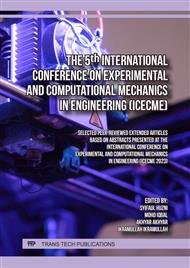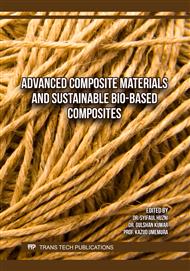[1]
R.C. Progelhof, J.L. Throne, and R.R. Ruetsch, "Methods for predicting the thermal conductivity of composite systems: A review," Polym. Eng. Sci., vol. 16, no. 9, p.615–625, 1976.
DOI: 10.1002/pen.760160905
Google Scholar
[2]
B.W. James, G.H. Wostenholm, G.S. Keen, and S.D. McIvor, "Prediction and measurement of the thermal conductivity of composite materials," J. Phys. D. Appl. Phys., vol. 20, no. 3, p.261–268, 1987.
DOI: 10.1088/0022-3727/20/3/004
Google Scholar
[3]
S.S. Purwaningsih and S. Sardjito, "Penentuan Konduktivitas Termal Efektif Bahan Komposit secara Analitik," Sigma-Mu, vol. 1, no. 1, p.1–7, 2007.
DOI: 10.35313/sigmamu.v1i1.904
Google Scholar
[4]
K. Pietrak and T.S. Wiśniewski, "A review of models for effective thermal conductivity of composite materials," J. Power Technol., vol. 95, no. 1, p.14–24, 2015.
Google Scholar
[5]
N. Burger, A. Laachachi, M. Ferriol, M. Lutz, V. Toniazzo, and D. Ruch, "Review of thermal conductivity in composites: Mechanisms, parameters and theory," Prog. Polym. Sci., vol. 61, p.1–28, 2016.
DOI: 10.1016/j.progpolymsci.2016.05.001
Google Scholar
[6]
R. D. Sweeting and X. L. Liu, "Measurement of thermal conductivity for fibre-reinforced composites," Compos. Part A Appl. Sci. Manuf., vol. 35, no. 7–8, p.933–938, 2004.
DOI: 10.1016/j.compositesa.2004.01.008
Google Scholar
[7]
H. Wibowo, T. Rusianto, and M. Ikhsan, "Pengaruh Kepadatan dan Ketebalan Terhadap Sifat Isolator Panas Papan Partikel Sekam Padi," J. Teknol., vol. 1, no. 2, p.107–111, 2008.
DOI: 10.25077/jif.2.2.68-73.2010
Google Scholar
[8]
H. Wibowo, T. Rusianto, and A. Sujatmiko, "Unjuk Kerja Papan Partikel Sekam Padi Sebagai Isolator Panas," no. Snttm Xii, p.23–24, 2013.
Google Scholar
[9]
D. Marcos-Gómez, J. Ching-Lloyd, M. R. Elizalde, W. J. Clegg, and J. M. Molina-Aldareguia, "Predicting the thermal conductivity of composite materials with imperfect interfaces," Compos. Sci. Technol., vol. 70, no. 16, p.2276–2283, 2010.
DOI: 10.1016/j.compscitech.2010.05.027
Google Scholar
[10]
F. Bustomi and A. Ghofur, "Uji Konduktivitas Termal Komposit Poliester Filler Serbuk Kayu Ulin (Eusideroxylon Zwageri)," Jtam Rotary, vol. 3, no. 2, p.233–244, 2021.
DOI: 10.20527/jtam_rotary.v3i2.4367
Google Scholar
[11]
H. Haisyah, Y. Arman, and A. Azwar, "Konduktivitas Termal Papan Komposit dari Sekam Padi dan Ampas Tebu," Prism. Fis., vol. 9, no. 3, p.208–212, 2021.
DOI: 10.26418/pf.v9i3.49856
Google Scholar
[12]
M. Hamid, "Strategi Pengembangan Sagu di Kabupaten Kepualauan Meranti," JIP (J. Ind. dan Perkota. ), vol. 18, no. 2, p.54, 2022.
DOI: 10.31258/jip.18.2.54-62
Google Scholar
[13]
T. H. Rasyid, Y. Kusumawaty, and S. Hadi, "The utilization of sago waste: Prospect and challenges," IOP Conf. Ser. Earth Environ. Sci., vol. 415, no. 1, 2020.
DOI: 10.1088/1755-1315/415/1/012023
Google Scholar
[14]
N. Amin, N. Sabli, S. Izhar, and H. Yoshida, "Sago wastes and its applications," Pertanika J. Sci. Technol., vol. 27, no. 4, p.1841–1862, 2019.
Google Scholar
[15]
J. C. Lai, W. A. W. A. Rahman, and W. Y. Toh, "Characterisation of sago pith waste and its composites," Ind. Crops Prod., vol. 45, p.319–326, 2013.
DOI: 10.1016/j.indcrop.2012.12.046
Google Scholar
[16]
T. C. Chiang, S. Hamdan, and M. S. Osman, "Urea Formaldehyde Composites Reinforced with Sago Fibres Analysis by FTIR, TGA, and DSC," Adv. Mater. Sci. Eng., vol. 2016, 2016.
DOI: 10.1155/2016/5954636
Google Scholar
[17]
A. N. Ahmad, S. A. Lim, N. Navaranjan, Y. I. Hsu, and H. Uyama, "Green sago starch nanoparticles as reinforcing material for green composites," Polymer (Guildf)., vol. 202, no. February, p.122646, 2020.
DOI: 10.1016/j.polymer.2020.122646
Google Scholar
[18]
W. Sutrisno, M. Rahayu, and D. R. Adhika, "Thermal properties of sago fiber-epoxy composite," Fibers, vol. 8, no. 1, p.1–13, 2020.
DOI: 10.3390/fib8010004
Google Scholar
[19]
E. T. Maryanto, A. Setyawan, T. S. B. Maria, and W. Astuti, "Analysis of the Performance of Natural Composite Materials Reinforced with Sago Sheath Fibers as an Alternative Material in Overcoming the Effect of Urban Heat Islands on Buildings," Buildings, vol. 13, no. 1, 2023.
DOI: 10.3390/buildings13010018
Google Scholar
[20]
Nusyirwan, H. Abral, M. Hakim, and R. Vadia, "The potential of rising husk fiber/native sago starch reinforced biocomposite to automotive component," IOP Conf. Ser. Mater. Sci. Eng., vol. 602, no. 1, 2019.
DOI: 10.1088/1757-899X/602/1/012085
Google Scholar
[21]
ASTM, ASTM Standard C177 - Standard Test Method for Steady-State Heat Flux Measurements and Thermal Transmission Properties by Means of the Guarded-Hot-Plate Apparatus, Annual Book of ASTM Standards. West Conshohocken, PA: ASTM International, 2008.
DOI: 10.1520/C0177-19
Google Scholar



